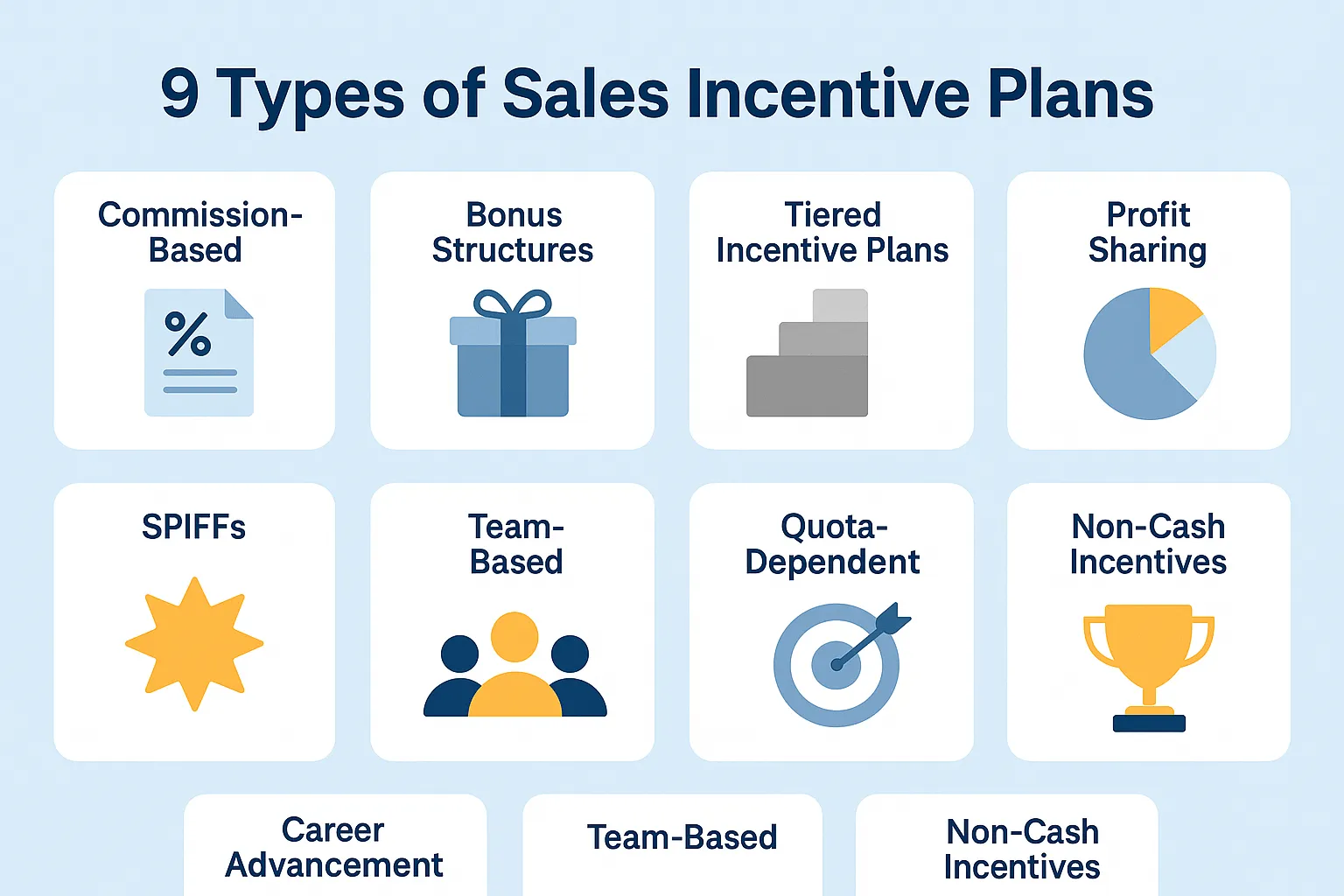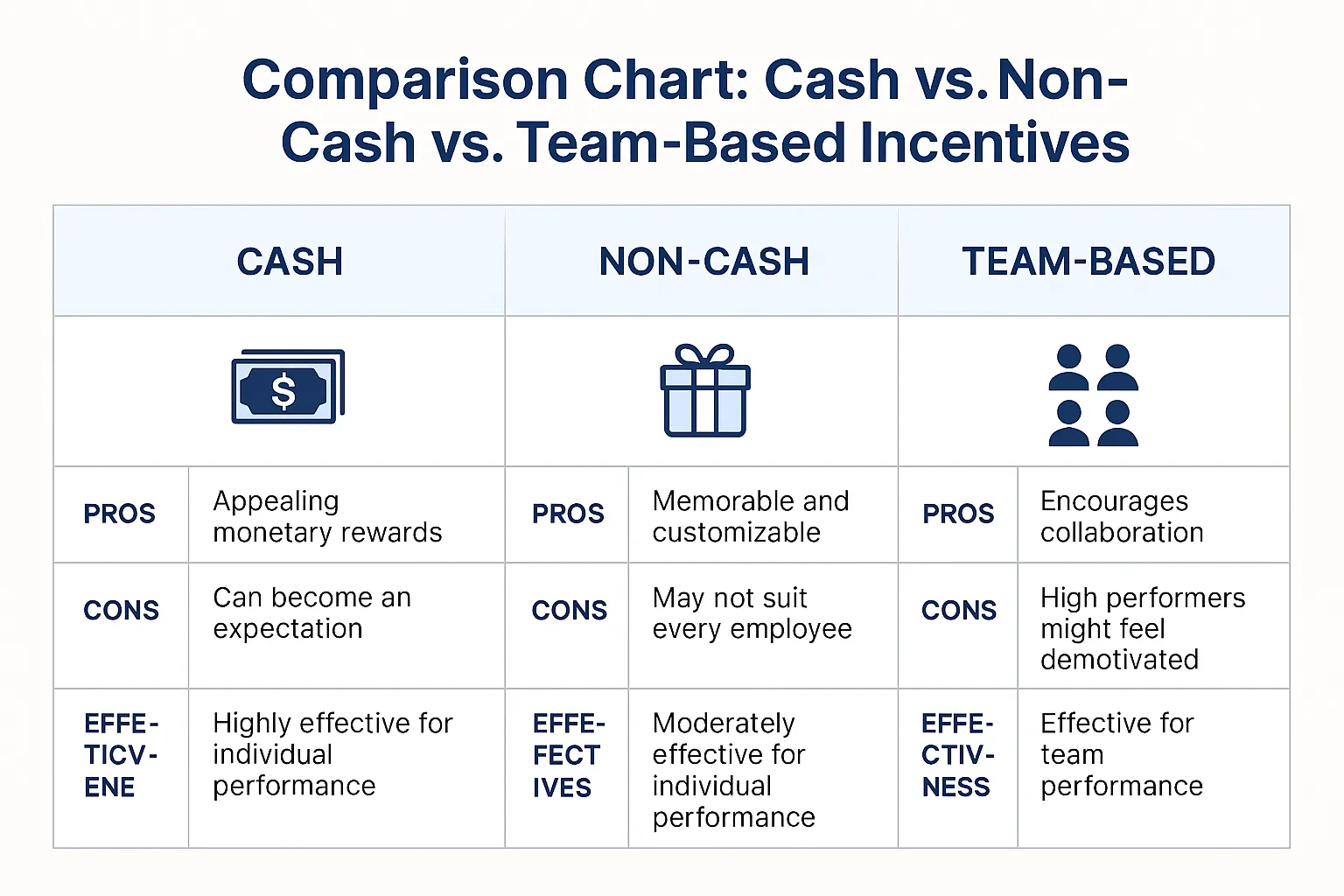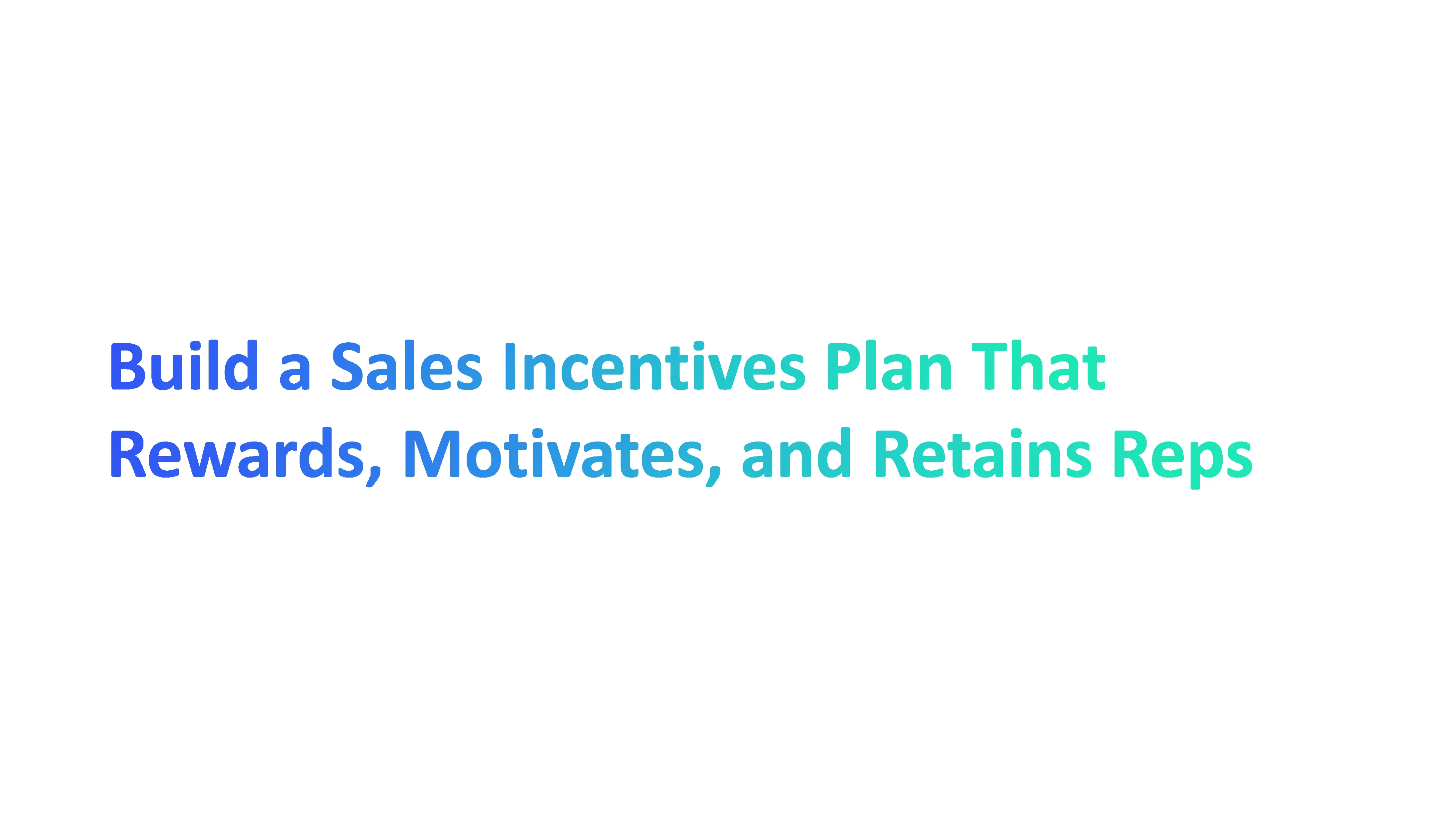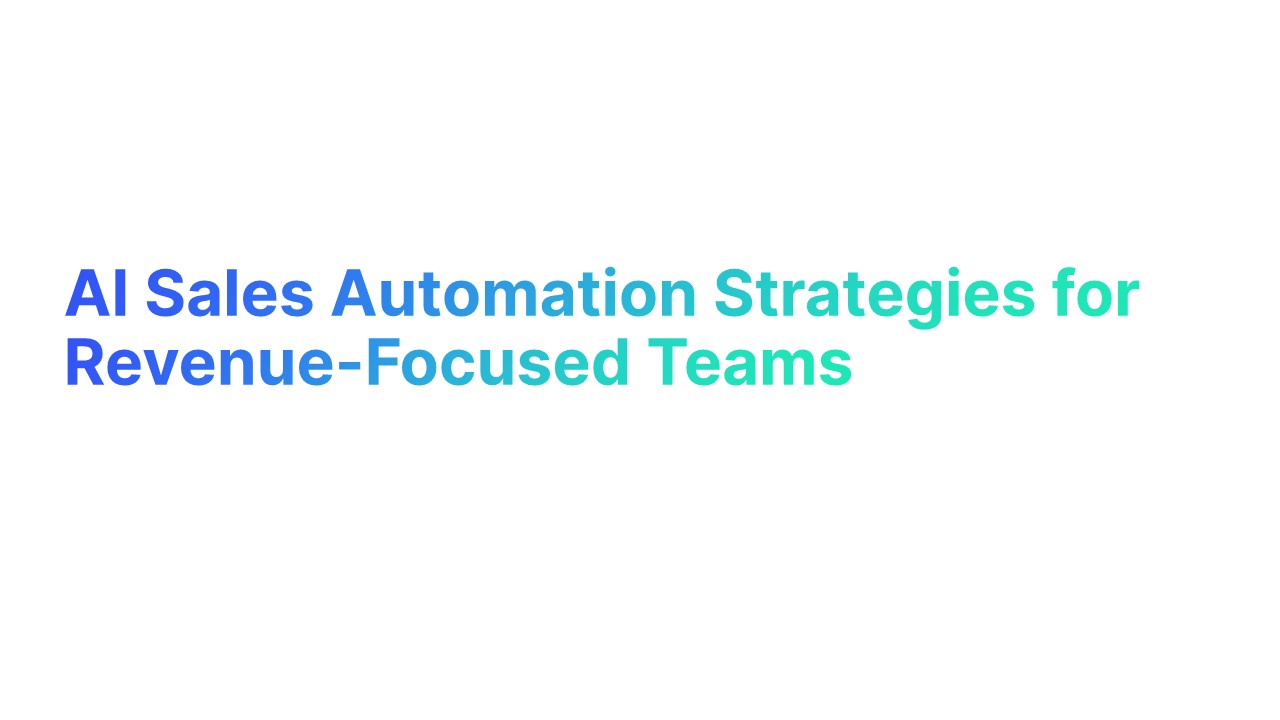You know your sales reps are critical to your company's success, but keeping them motivated can be tricky without the right approach. A good sales incentives plan can help you reward hard work, encourage collaboration among your sales team, and support employee retention.
According to Gallup, companies with highly engaged employees enjoy up to 20% higher profitability, making your choice of sales incentive programs even more crucial.
Whether you're using cash rewards, non monetary rewards, or providing professional development opportunities, creating a clear, fair, and effective incentive structure is essential to maintaining sales performance and meeting your sales goals.
What is a Sales Incentive Plan?

If you're managing a sales team, you know hitting sales targets isn't just about numbers — it's about people. A sales incentive plan is a structure that rewards sales reps for specific actions, deals closed, or milestones achieved.
The goal? To keep them engaged, productive, and invested in your company goals.
These plans aren’t just about cash bonuses. They can be designed around non monetary incentives, like learning credits or public recognition. Or even tangible rewards like tech gadgets or exclusive experiences for top performers.
Well-crafted sales compensation plans are linked to job satisfaction, especially in industries with long sales cycles and a complex sales process.
According to McKinsey, over 60% of reps say the right incentive structure makes them more likely to stay with a company.
Importance of a Well-Designed Sales Incentive Program

Let’s be honest—if your sales manager or sales leaders aren’t thinking about how to reward reps, you’re probably losing good people.
A well-structured sales incentive program does more than offer perks—it keeps your team focused, valued, and committed.
And here’s the truth: Gallup found that only 21% of employees feel strongly motivated—largely due to a lack of recognition and incentives.
When you motivate your sales team through smart planning, you improve more than just sales performance.
Here’s what a strong program impacts:
- Employee engagement and retention
- Recognized reps are nearly 3x more likely to stay long term.
- Customer retention improves when your team feels stable and confident.
- Support for long or complex sales cycles
- Plans tailored to long sales cycles and the sales pipeline help reps stay consistent.
- Sales processes feel less transactional, more strategic.
- Clarity around expectations
- Defining sales quotas, what counts as a closed deal, or a key stage in the sales cycle eliminates confusion.
- It aligns with your incentive structure and keeps the entire team accountable.
9 Types of Sales Incentive Plans

Not every rep works the same way—so why should every incentive be the same? The right mix of sales incentive plans helps you reward effort, improve morale, and align with real outcomes.
Here are 9 proven types to consider.
1. Commission-Based Plans
This is the most straightforward method—reps earn a percentage of every closed deal. It's simple, motivating, and easy to tie to revenue.
- Works best in short sales cycle models
- Popular in B2C and transactional sales setups
- Great for tracking individual sales rep performance
2. Bonus Structures
Flat bonuses are tied to hitting sales quotas or surpassing expectations. These are great when you want to push performance during a specific window.
- Can be quarterly, monthly, or per sales contest
- Help motivate sales reps during high-stakes periods
- Must be part of a fair incentive structure
3. Tiered Incentive Plans
This model rewards reps more as they sell more. It’s a motivator for those who go above the standard.
- Encourages competition among your sales force
- Helps to boost engagement naturally
- Works best when sales data is used to set fair thresholds
4. Profit Sharing Plans
Instead of paying per sale, reps share in company profits. This helps align them with the business's long-term success.
- Works well for account managers handling long-term clients
- Encourages reps to care about customer demand and retention
- Supports long-term employee engagement
5. SPIFFs (Sales Performance Incentive Funds)
These are short-term contests or surprise incentives that drive urgency. Think of them as fun sprints, not marathons.
- Ideal for clearing inventory or pushing slow-moving products
- Pair well with traditional incentives like merchandise
- Great for encouraging reps across all stages of the sales pipeline
“SPIFFs are like espresso shots for sales energy—quick, sharp, and instantly effective.” — Forbes
6. Team-Based Incentives
Rewarding groups encourages collaboration instead of competition. This model is powerful when team-selling is core to your sales processes.
- Use split incentives or split sales incentives fairly
- Reinforces shared responsibility and success
- Aids in overall sales team's performance
7. Quota-Dependent Plans
These are tied directly to monthly or quarterly sales targets. It gives structure and clarity, especially for larger sales teams.
- You can tailor it to motivate employees at different levels
- Use sales training alongside to improve quota attainment
- Keep it flexible to adapt to market or customer feedback
8. Career Advancement Incentives
Not all rewards are money-based. Recognition, promotions, and access to leadership roles can mean more than cash.
- Especially effective for high-potential top performers
- Enhances job satisfaction and long-term commitment
- Helps shape a more driven sales compensation plan
9. Non-Cash Incentives for Sales Reps
Cash isn't always king. Many reps appreciate experiences, non cash rewards, or even extra time off.
- Includes tech gadgets, gift cards, and curated experiences
- Improves productivity boost and morale
- Helps in rewarding reps in personalized, thoughtful ways
According to SHRM, 65% of employees prefer non-cash rewards when they are personal and meaningful.
When choosing the right sales incentive plan, remember it’s not about the flashiest prize. It’s about making your reps feel seen, valued, and motivated to grow. An effective sales incentive program makes that happen—without needing to overcomplicate the process. What really makes it meaningful is personalization, and partnering with custom awards makers ensures each award reflects your team’s unique achievements and personality.
Comparison Guide: Choose the Right Sales Incentive Plan for Your Team

Not sure which sales incentive plan makes the most sense for your team? This quick comparison breaks down each type by when to use it, what it costs, and the kind of impact you can expect—so you can choose with clarity.

How to Create an Effective Sales Incentive Program

Designing a successful sales incentive isn’t about throwing money at your team. It’s about creating a structure that feels fair, achievable, and motivating. Let’s walk through how you can make it work—step by step.
1. Set Clear Sales Goals
Your incentive plan should always begin with clear, specific goals. If reps don’t know what’s expected, they can’t succeed.
- Align goals with actual outcomes (e.g., new leads, closed deals)
- Avoid vague targets—precision matters
- Review and revise goals each quarter
“Ambiguity kills motivation. People perform best when expectations are clear.” — Harvard Business Review
2. Choose the Right Mix of Incentives
Not everyone’s motivated by the same thing. A balanced plan speaks to your top performers, steady contributors, and new hires alike.
- Use a mix of financial and experience-based rewards
- Include options that resonate with different personality types
- Build around your right sales incentive program, not just what competitors do
3. Incorporate Cash Rewards and Bonuses
Yes, money matters—but only if it’s part of a larger system. Bonuses work best when they feel earned, not just handed out.
- Tie rewards to performance milestones
- Make bonuses part of a great incentive system, not the whole story
- Avoid over-relying on cash if it drains budget with little return
According to Deloitte, “High-performing incentive plans lead to a 20% increase in productivity when tied to strategic goals.”
4. Design an Analytics-Based Sales Incentives Program
Data keeps the plan honest. If you’re guessing, you’re likely missing what really moves your reps.
- Use real sales data to decide what to reward
- Monitor rep progress and adjust thresholds
- Let reports drive better structure—not gut instinct
5. Foster Healthy Competition with Sales Contests
Everyone loves a bit of fun. Done right, a sales contest creates energy without creating tension.
- Keep rules fair and transparent
- Include daily or weekly wins, not just one big prize
- Give credit for effort, not just results
6. Align Incentives with the Sales Process
Make sure your plan doesn’t clash with how your team actually sells. This is especially true in complex sales processes.
- Don’t reward speed if deals require patience
- Create touchpoint-based rewards for long deals
- Reflect the natural rhythm of your sales cycle
7. Involve Sales Managers in Program Design
Your sales manager knows what really motivates the team. If you build incentives in isolation, they’re likely to flop.
- Ask for feedback before rolling out the plan
- Give managers room to adjust based on team feedback
- Share results regularly and improve together
8. Align with Long-Term Goals
Short wins are great—but not if they derail big-picture progress. The right sales incentives should support retention and team health.
- Connect rewards to company goals
- Include growth paths, like presales incentives or development tracks
- Watch for red flags where rewards hurt collaboration or morale
Long-term motivation comes from purpose, not prizes.
Industry-Specific Sales Incentive Ideas

One-size incentives rarely work across every team. Sales reps in SaaS, retail, or enterprise all work in different ways—and your reward system should reflect that. Let’s look at tailored ideas for each.
1. For SaaS & Tech Sales Teams
Tech reps often deal with long funnels and layered decision-making. What works here is blending recognition, training, and milestone-based incentives.
- Reward product demos, not just closed deals
- Include learning credits or certifications as non-cash rewards
- Use omnichannel sales incentives for reps working across email, video, and product-led outreach
According to Xactly, SaaS companies that tie incentives to onboarding completion see a 12% increase in first-quarter rep performance.
2. For Retail Sales
Retail teams work fast and face constant customer interaction. Their rewards need to be visible, fun, and real-time.
- Offer micro-rewards for high service ratings
- Recognize consistency as much as peak performance
- Include visuals like leaderboards or shoutouts to motivate reps
"Retail reps respond best to things they can see and track. If it’s visible, it’s motivating.” — RetailWire
3. For Enterprise/B2B Sales
Enterprise reps need long-term focus and patience. Here, structure and delayed gratification work best.
- Use types of sales incentives like profit-sharing, annual bonuses, and deal-stage rewards
- Give flexibility for longer sales cycles and procurement processes
- Offer access to leadership or strategy sessions as part of their rewards
4. For SDRs and Inside Sales
These reps grind through calls, emails, and rejection daily. Small wins and real recognition go a long way.
- Set achievable micro-goals: meetings booked, responses secured
- Use weekly incentives to maintain energy
- Mix financial rewards with team praise to motivate reps
Bridge Group reports that SDRs with weekly performance incentives are 18% more likely to meet pipeline goals.
5. For Remote or Hybrid Teams
Remote reps often miss the buzz of in-office energy. Incentives here need to create connection, not just reward output.
- Send personalized thank-you kits or surprise lunch deliveries
- Use video highlights to share weekly wins
- Consider peer-nominated awards to build visibility and trust
Tip: Pair omnichannel sales incentives with regular video check-ins so reps feel seen across all platforms.
Every team is unique, and that’s the point. When you match the right types of sales incentives to how your reps actually work, you don’t just drive performance—you build real commitment. And yes, the right incentives really do motivate reps without overcomplicating your plan.
FAQs About Sales Incentive Plans

1. What is a good sales incentive plan?
A good sales incentive plan rewards effort and results without feeling complicated or unfair. It sets clear goals, aligns with your business priorities, and offers a healthy mix of monetary and non-monetary rewards. More importantly, it makes your sales reps feel seen and motivated—not stressed or confused.
2. What is the most widely used sales incentive program?
The most common approach is the commission-based plan—where reps earn a percentage of each sale they make. It’s popular because it’s simple, scalable, and directly tied to performance. But many teams also combine this with bonuses or team-based rewards to create balance and avoid burnout.
3. How do you calculate a sales incentive plan?
That depends on your structure. For commissions, you’ll multiply the revenue generated by a set percentage (like 5%). For bonuses, you might use a tiered structure—say, $500 for hitting quota, $750 for exceeding it. The key is to make the math transparent so reps know what they’re working toward.
4. What is an example of a sales incentive structure?
Let’s say your rep has a $50,000 monthly target. You offer:
- 5% commission on the first $50,000
- 7% if they pass $60,000
- And a $1,000 bonus if they also close 10 new accounts
This combines tiered rewards and bonus triggers into one motivating plan.
5. What is the 80/20 sales incentive rule?
The 80/20 rule (or Pareto Principle) in sales means that 80% of your results often come from 20% of your reps. In incentive terms, this reminds you not to focus only on top performers. Your plan should encourage middle-tier reps to grow—so the whole team improves, not just the few at the top.
6. What is a short-term incentive to boost sales?
SPIFFs (short-term bonuses) are great for this. They’re quick-hit rewards tied to a specific product push, time window, or activity—like $100 for each demo booked this week. They create urgency and excitement, especially when reps need an extra push to finish strong.
Conclusion
Building a sales incentives plan doesn’t have to be complicated—but it does need to be thoughtful. If you want to truly reward, motivate, and retain your reps, your plan should feel fair, flexible, and aligned with how your team actually works.
Whether you're working with commissions, SPIFFs, or non-cash rewards, what matters most is that your reps feel recognized and driven to perform. Take the time to listen to what motivates them, test what works, and adjust as you go.
No plan is perfect out of the gate—but the right one evolves with your team. And when it clicks? You won’t just see results—you’ll feel the energy shift. Ready to build yours? Start where it matters most: with your people.





.webp)


